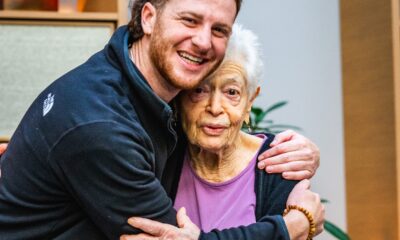
Lifestyle

The Tattooist of Auschwitz moves hearts in TV adaptation
Recently released on M-Net (DStv Channel 101), The Tattooist of Auschwitz is based on the bestselling 2018 novel by Heather Morris which tells the true story of Holocaust survivor Lale Sokolov. Speaking exclusively to the SA Jewish Report, Israeli director Tali Shalom-Ezer and Scottish executive producer Claire Mundell provided a behind-the-scenes look at making the series and confronting difficult material.
While using his position as a tattooist of prisoners in Auschwitz to help his fellow captives, Sokolov found himself falling in love in the most unlikely of places. A Sky and Peacock original drama, The Tattooist of Auschwitz brings his story to a wider audience.
“As a producer, you’re always looking for the sort of story that captures people on a global scale,” says Mundell, the founder and creative director of Synchronicity Films. “The way Heather Morris’s book captured the hearts and minds of so many people around the world was testament to the power of Lale and Gita’s unique love story. The book brought an audience to the story of one man’s experiences of the Holocaust in a way that that few books have ever been able to do.”
The audience itself was also far more diverse than the one that would typically read a non-fiction book about the Holocaust, she says. “It was a great opportunity to use the power of drama to speak to a core audience of Jewish people, to people affected directly by the Holocaust. But we’re also bringing it to a wider audience, many of whom I don’t think would have come to this material without the love story element.”
Shalom-Ezer agrees. “There’s something so incredible about this story that it just speaks to so many people,” she says. “It’s almost impossible to understand what Lale and Gita went through.”
The fact that it did happen is what has attracted so many people to the story, she said. “It somehow makes you believe in humankind again. I believe this is because Lale and Gita were so brave and exceptional.”
Yet producing a love story in the context of the Holocaust posed a unique challenge. The tone of the series was a daily conversation, says Mundell. “We had to strike a balance where we could be respectful in what we were portraying. You cannot, of course, recreate Auschwitz, all you can do is give an audience a sense of what that suffering and horror might have been like.
“At the same time, our objective was to bring the show to the biggest, most diverse audience. You have to find enough light and balance in the emotion of the story to enable people to stay with it, because otherwise, it would just be too traumatic to watch. It’s the hope in the DNA of the story that really pulls people in. Although it’s harrowing to watch in places – as it should be – the hope gets people through emotionally.”
Ezer-Shalom says her Jewish identity reinforced the need to approach the subject matter with particular sensitivity. “Many of the creators of the show, including myself and cinematographer David Katznelson are Jewish, and we have some connection to this story,” she says. Ezer-Shalom’s grandfather is a Holocaust survivor whose first wife, daughter, siblings, and parents were murdered at Auschwitz, and Katznelson’s father also survived the concentration camps.
“So, this story is so meaningful for both of us,” she says. “We were always talking about whether we felt that our family members would think that it’s respectful. Most of the prisoners in Auschwitz were murdered there, they didn’t have the same luck as Lale and Gita.” In their ongoing discussions, their guiding light was always to focus on trying to tell Sokolov’s story in the most authentic way possible, says Shalom-Ezer. Considering the traumatic subject matter, counselling was also constantly available on set.
It’s impossible to understand fully what happened at Auschwitz, Shalom-Ezer says. It’s one of the biggest traumas in human history and as you read survivor testimonies, it’s so hard to comprehend. “Yet, it did happen, so I think we all want to understand how something like this could in fact happen,” she says. This is why she believes there’s such an enduring desire to engage with such stories.
In increasing the series’ relevance to a contemporary audience, the writers tried to depict the ongoing impact of the Holocaust on Lale in his old age. “A significant change we made in the adaptation was to incorporate scenes between Lale and the novelist Heather Morris, played by Harvey Keitel and Melanie Lynskey, respectively,” says Mundell.
Despite the fact that on one level, Lale and Gita had a happy ending, the trauma of Auschwitz never left them. “Through Lale’s memories, we’re trying to honour the fact that the survivors very soon will be gone, and once that happens, who will be there to remind us of what occurred? This was a way to try to bring that to life for a mainstream audience.”
At a time when the trauma caused by hatred is all too real, the series is also arguably that much more relevant today. The show was shot and mainly completed before 7 October, says Shalom-Ezer. Yet its first release was in May 2024. “We live in such a violent time, so remembering past traumas, of course, resonates with traumas that are happening now,” she says. While remotely editing the film with Mundell and the team in October from her Tel Aviv home, Shalom-Ezer in fact had to run back and forth to her safe room.
“We could never have envisaged that the show would be released in the context that it was,” says Mundell. “I hope it makes people reflect a bit more on the consequences of intolerance, hatred, and antisemitism, and where these things lead. The story is ultimately about the power of love and how as human beings, somehow, in these unbelievably dire situations, we can find it within ourselves to connect with each other.”










